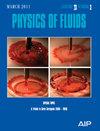Electro-osmotic flow through nanochannel with different surface charge configurations: A molecular dynamics simulation study
IF 4.1
2区 工程技术
Q1 MECHANICS
引用次数: 14
Abstract
Electro-osmotic flow behavior through rectangular graphene nanochannels with different charge (negative in nature) configurations is discussed in detail using non-equilibrium molecular dynamics (MD) simulations. Alternate patterning of charged and neutral stripes on the surface of the nanochannel lowers the water permeance and electro-osmotic flow velocity through the nanochannel. For all of the charge configurations, water permeance and electro-osmotic velocity through the nanochannel increase as surface charge density (σ) increases from 0.005 to 0.025 C m−2. This can be attributed to the increase in the number of counterions (Na+ ions) near the surface of the nanochannel. However, with further increase in σ, water permeance and electro-osmotic velocity through the nanochannel gradually decrease despite the increase in the number of counterions near the surface of the nanochannel. This is because of the significant increase in electrostatic interaction between the water molecules and the surface of the nanochannel. At a lower value of σ ( σ≤0.025 C m−2), the overall interaction between the water molecules and the surface of the nanochannel is significantly dominated by van der Waals (vdW) interactions (electrostatic/vdW ≤0.40). The slip velocity of water molecules in the charged stripe portion of the wall (SlipCharge) is higher as compared to the slip velocity of water molecules in the neutral stripe portion (SlipNeutral) except at σ=0.2 cm−2. This difference between SlipCharge and SlipNeutral is highest at σ=0.025 C m−2 with SlipCharge > SlipNeutral, for all of the charge configurations.具有不同表面电荷结构的纳米通道电渗透流动:分子动力学模拟研究
利用非平衡分子动力学(MD)模拟,详细讨论了具有不同电荷(本质上是负电荷)构型的矩形石墨烯纳米通道的电渗透流动行为。纳米通道表面带电条纹和中性条纹的交替图案降低了通过纳米通道的水渗透率和电渗透流速。对于所有电荷构型,随着表面电荷密度(σ)从0.005增加到0.025 C m−2,通过纳米通道的水渗透率和电渗透速度均有所增加。这可以归因于纳米通道表面附近的反离子(Na+离子)数量的增加。然而,随着σ的进一步增大,尽管纳米通道表面的反离子数量增加,但通过纳米通道的水渗透率和电渗透速度逐渐降低。这是因为水分子和纳米通道表面之间的静电相互作用显著增加。在较低的σ值(σ≤0.025 C m−2)下,水分子与纳米通道表面的整体相互作用明显由范德华相互作用(vdW)主导(静电/vdW≤0.40)。除σ=0.2 cm−2外,壁面带电条纹部分水分子的滑移速度(SlipCharge)高于中性条纹部分水分子的滑移速度(SlipNeutral)。在σ=0.025 C m−2时,滑移电荷与滑移中性之间的差异最大,且滑移电荷>滑移中性。
本文章由计算机程序翻译,如有差异,请以英文原文为准。
求助全文
约1分钟内获得全文
求助全文
来源期刊

Physics of Fluids
物理-力学
CiteScore
6.50
自引率
41.30%
发文量
2063
审稿时长
2.6 months
期刊介绍:
Physics of Fluids (PoF) is a preeminent journal devoted to publishing original theoretical, computational, and experimental contributions to the understanding of the dynamics of gases, liquids, and complex or multiphase fluids. Topics published in PoF are diverse and reflect the most important subjects in fluid dynamics, including, but not limited to:
-Acoustics
-Aerospace and aeronautical flow
-Astrophysical flow
-Biofluid mechanics
-Cavitation and cavitating flows
-Combustion flows
-Complex fluids
-Compressible flow
-Computational fluid dynamics
-Contact lines
-Continuum mechanics
-Convection
-Cryogenic flow
-Droplets
-Electrical and magnetic effects in fluid flow
-Foam, bubble, and film mechanics
-Flow control
-Flow instability and transition
-Flow orientation and anisotropy
-Flows with other transport phenomena
-Flows with complex boundary conditions
-Flow visualization
-Fluid mechanics
-Fluid physical properties
-Fluid–structure interactions
-Free surface flows
-Geophysical flow
-Interfacial flow
-Knudsen flow
-Laminar flow
-Liquid crystals
-Mathematics of fluids
-Micro- and nanofluid mechanics
-Mixing
-Molecular theory
-Nanofluidics
-Particulate, multiphase, and granular flow
-Processing flows
-Relativistic fluid mechanics
-Rotating flows
-Shock wave phenomena
-Soft matter
-Stratified flows
-Supercritical fluids
-Superfluidity
-Thermodynamics of flow systems
-Transonic flow
-Turbulent flow
-Viscous and non-Newtonian flow
-Viscoelasticity
-Vortex dynamics
-Waves
 求助内容:
求助内容: 应助结果提醒方式:
应助结果提醒方式:


